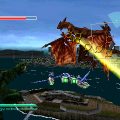EOS (イオス): Edge of Skyhigh
Developer: Micronet
Release Date: 1997
Platforms: PlayStation
This article is part of our Japanese Obscurities feature. We put out a whole book about them, which is available as both a full color hardcover and a Kindle ebook from Amazon! If you’d like to see more of these features, please check out the book and if you enjoyed it, leave a five star review so we can do a follow up with even more interesting, offbeat, or historically important Japanese games!
Taking after arcade classics like Space Harrier and After Burner, EOS: Edge of Skyhigh is a 3D rail shooter where you pilot a transforming mecha, using both a rapid fire gun and lock-on missiles to destroy hordes of enemies. The jet plane form is a little weaker but its smaller size makes it easier to dodge attacks, while the robot form is slightly more powerful but also makes it a bigger target. The robot form also features a powerful burst attack, a volley of powerful shots which is useful for taking down larger foes. You can use the shoulder triggers to speed up or slow down, but the difference in speed is often imperceptible.
Like many 3D flying games, it’s hard to judge the distance between your character and the enemy’s attacks, and most bosses don’t really telegraph their moves, making it difficult to dodge them until you’ve encountered them a few times and know the safe zones. Your mecha can take a handful of shots before getting destroyed, and while you only have a single life, there are mid-level checkpoints that let you resume progress, and you can continue as often as you want. This makes the action fairly breezy, but with six stages, the final one consisting only of a boss battle, the game can be finished pretty quickly. Without any higher difficulty modes, the only replay value relies on increasing your score and acing every stage. Between levels are no-frills mission briefings, though it includes some well-known voice actors, including Shigeru Nakahara (Shou from Aura Battler Dunbine, Android 17 from Dragon Ball Z), who coincidentally was also in Panzer Dragon Zwei.
It may be brief, but EOS nails the riveting thrill of being a mecha pilot. The 3D visuals are smooth and look fantastic, with an outstanding soundtrack to boot. When you move around, the camera tilts with it, giving an intense feeling with every motion, but not so overdone that it’s dizzying. The level design can be a little simple, repeating the same scenery over and over, just with different enemy formations. This makes it feel like a late 80s/early 90s 3D rail shooter, rather than contemporary games like Star Fox 64 or Panzer Dragoon, which featured far more elaborate, cinematic stages. But it hits the fundamentals so well that it doesn’t really matter all that much, making for a must-play for genre enthusiasts. It’s also well worth checking out Sony’s Omega Boost and Jaleco’s Vanark, both similar 3D rail shooters that were fortunate enough to be released in North America.


